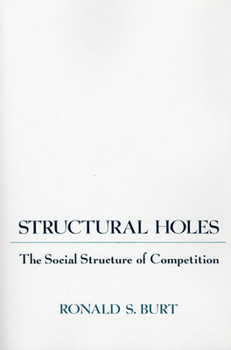Structural Holes: The Social Structure of Competition
Select Format
Select Condition 
Book Overview
This work describes the social structural theory of competition that has developed from the 1970s to the 1990s. The contrast between perfect competition and monopoly is replaced with a network image... This description may be from another edition of this product.
Format:Paperback
Language:English
ISBN:0674843711
ISBN13:9780674843714
Release Date:August 1995
Publisher:Harvard University Press
Length:324 Pages
Weight:1.05 lbs.
Dimensions:0.8" x 6.1" x 9.4"
Customer Reviews
2 ratings
Structural Holes Matter
Published by Thriftbooks.com User , 16 years ago
Professor Ronald Burt's book "Structural Holes: the Social Structure of Competition", which was written in 1992, is a seminal publication and a must read for anyone interested in network theory. The book has an academic flavour but is well written, with many easy to understand examples. Burt's central thesis is that structural holes in business networks are very important. A structural hole is a gap between two individuals. When the two are connected through a third individual important advantages accrue for the third individual, who may employ a tertius strategy. Burt ascribes four signature qualities of competition to his structural hole argument (pp. 3-4) as follows: * competition is a matter of relationships not player attributes; * competition is a quality of emergent relationships; * competition is a process, not just a result; and * imperfect competition is a matter of freedom, not just power. I find Burt's argument compelling, especially Given Burt's evidence and rich examples, which are expanded in his second book "Brokerage and Closure: An Introduction to Social Capital". I also find his argument on social capital to be compelling - Social Capital "is a thing owned jointly by the parties to a relationship. No one player has exclusive ownership rights to social capital"(p. 9). The structural hole thesis uses competition and social capital to develop a theory of network structural autonomy, where an individual can consciously weave the network to advantage. Burt then provides a series of network measures which have since found their way into special computer programs such as UCINET and NetMiner 3 . Even though the book is now over 15 years old I found much to interest me. I believe the book is a must read for serious knowledge practitioners and network analysts. For me at least, structural holes matter! Regards, Graham
The network structure of social capital
Published by Thriftbooks.com User , 24 years ago
"The Network Structure of Social Capital" by RonaldBurt at the U Chicago Graduate School of Business is one paper thatheld my attention. "Social capital" is a metaphor for the accumulated wealth built up in a personal network; better connected people have more social capital, and as a result they gain advantages in social situations. Burt's thesis is that social capital depends on not just the size of your social network, but also its nature and structure. Here's a brief summary.If you're looking to get ahead, you should aim to build a circle of work and personal contacts that is broad and diverse. The more diverse your contacts, the more likely it is that you will find an opportunity through them. It's particularly important not to narrow your networking efforts to a single clique of all like-minded people who all know each other and don't mix much with others; maintaining such connections gets in the way of more productive efforts that bring in a steady mix of new faces. When you have a network that gives you the opportunity to connect two widely diverse parts of an enterprise together, or when you can bring friends together who know you but don't know each other, you stand in the role of _gaudius tertius_, "the third who benefits". Even if you don't explicitly control the relationship (now I don't want to sound too mercenary here; remember, this is social science, not Emily Post) you will still benefit from the control of and access to flow between two elements that have been insulated from each other. The pieces of an organization's or a population's network that don't communicate much are insulated by what Burt calls "Structural Holes" (the title of one of his books). He goes into detail studying behavior and networks of senior managers in an organization trying to find structural holes and predicting with a fair degree of accuracy who will get ahead in the corporate game by how big people's networks are (bigger is better), how centered their networks are on their bosses (all things equal, you'd rather know people who your boss doesn't -- but take advantage of your boss's network to bootstrap your own) and the overlaps in their contacts networks (be the bridge between people who don't know each other). A good read, if you're into theory, though a bit of a slog at times. The author appears to bear a bit of a grudge against some fellow academics who disagree with his conclusions - those academics went off and formed a little clique that's busy quoting each other and recommending that senior managers build little cliques within their own companies. I believe that eclectic networks bring the best results persuasion by my nature. (Witness Vacuum.) [From Vacuum #11. http://vacuum.mi.org] END





